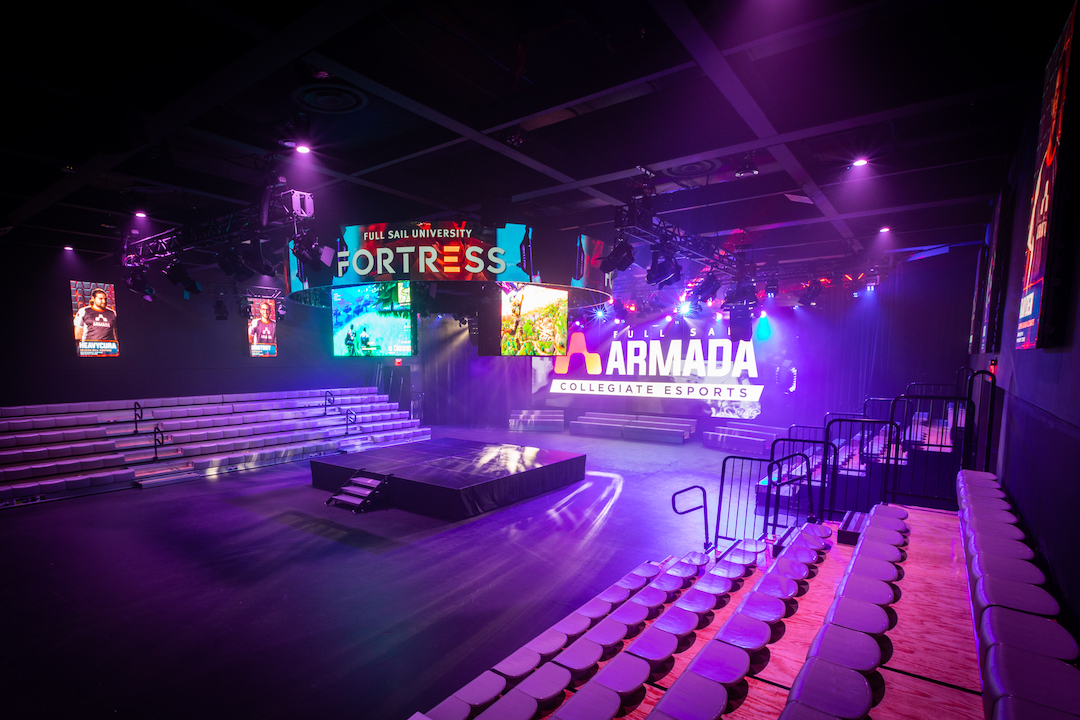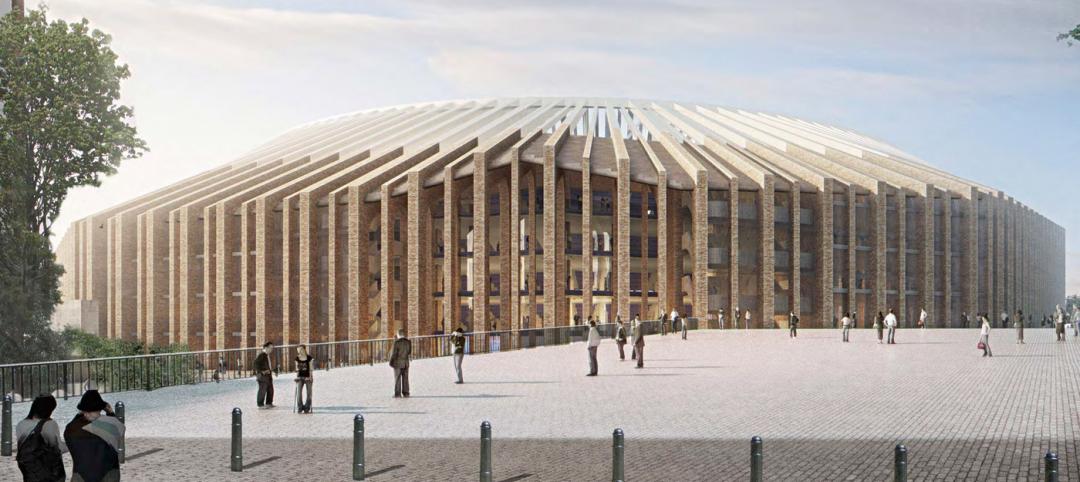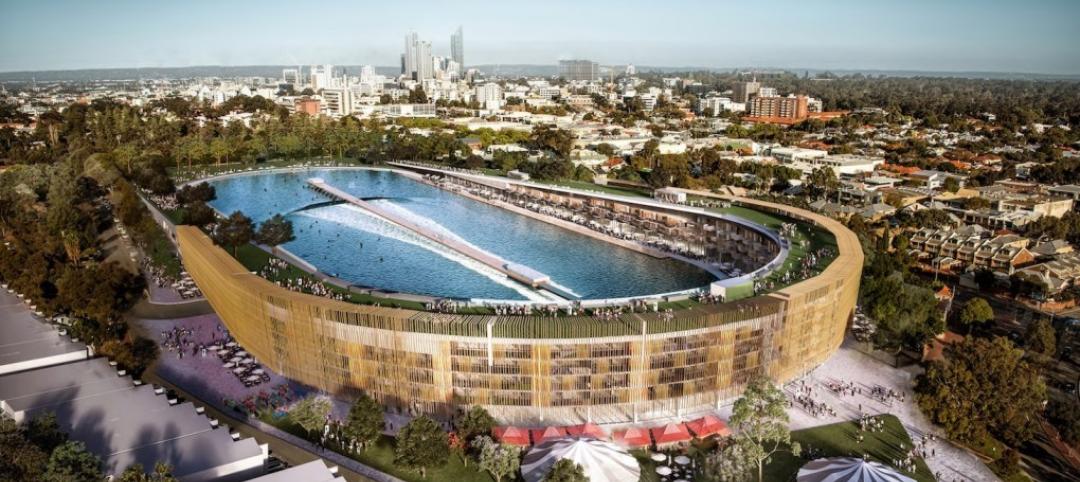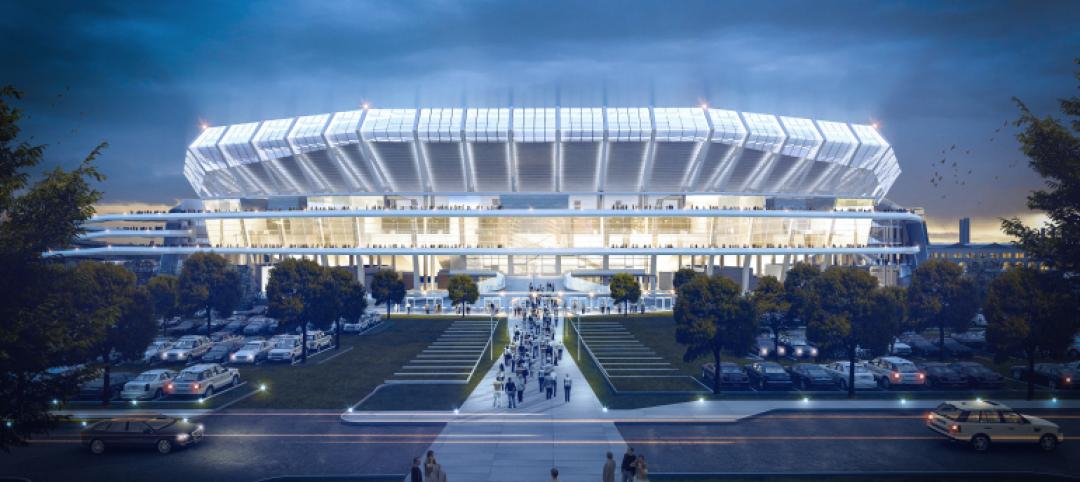The success and popularity of eSports is no longer a surprise to anyone. Purpose-built eSports stadiums are popping up both around the country and the world, hosting events with audiences and prize pools pushing well into the millions.
But now the eSports rocket ship is continuing its journey through the stratosphere, pushing ahead on another front: the college campus. In 2018, Ashland University became the first school in the country to offer scholarships (up to $4,000) for competitive gaming. Other colleges quickly followed suit, and there are now over 60 colleges in the United States offering scholarships in a variety of different games. Robert Morris University offers a scholarship for the game League of Legends that totals $76,000 over a four-year period (50% tuition and 50% room and board per year), rivaling scholarships offered for more traditional sports.
With money like that being thrown around, it’s clear video games are no longer just a hobby; eSports have become a very real and very unique recruiting tool, especially among smaller schools that can’t compete with D-I schools in sports like football and basketball.
See Also: Gamers paradise: The rise of eSports arenas
“The smaller D-II, D-III, and Ivy League schools now have an opportunity to compete on a larger scale and are really embracing eSports,” said Benedict Dubbs, Jr. AIA, LEED A.P., Principal, Murray Associates Architects. “Where else can ‘David beat Goliath’ anywhere in the world without a road trip?”
But in order for David to beat Goliath, they need an arena to fight in. Which is why small colleges such as Harrisburg University of Science and Technology (HU) and Full Sail University have taken it upon themselves to create dedicated eSports arenas and facilities for their student eSports athletes.
HU’s eSports Training Arena
The Storm, HU’s competitive eSports team, recently received a new training facility courtesy of Murray Associates Architects. The architect took a vacant dance studio in the Whitaker Center for Science and the Arts and turned it into HU’s eSports Training Arena.
The 2,460-gsf facility features 24 gaming rigs, a coaching suite, and a student lounge, all designed to enhance the team’s coaching and player collaboration, interactions, and skill development. Flexibility was also a main design focus for the space. Some competitive games are played 1 vs 1, while others pit larger teams against each other. Different games require different set ups, and the relatively small 2,400-sf space needed to be able to accommodate them all.
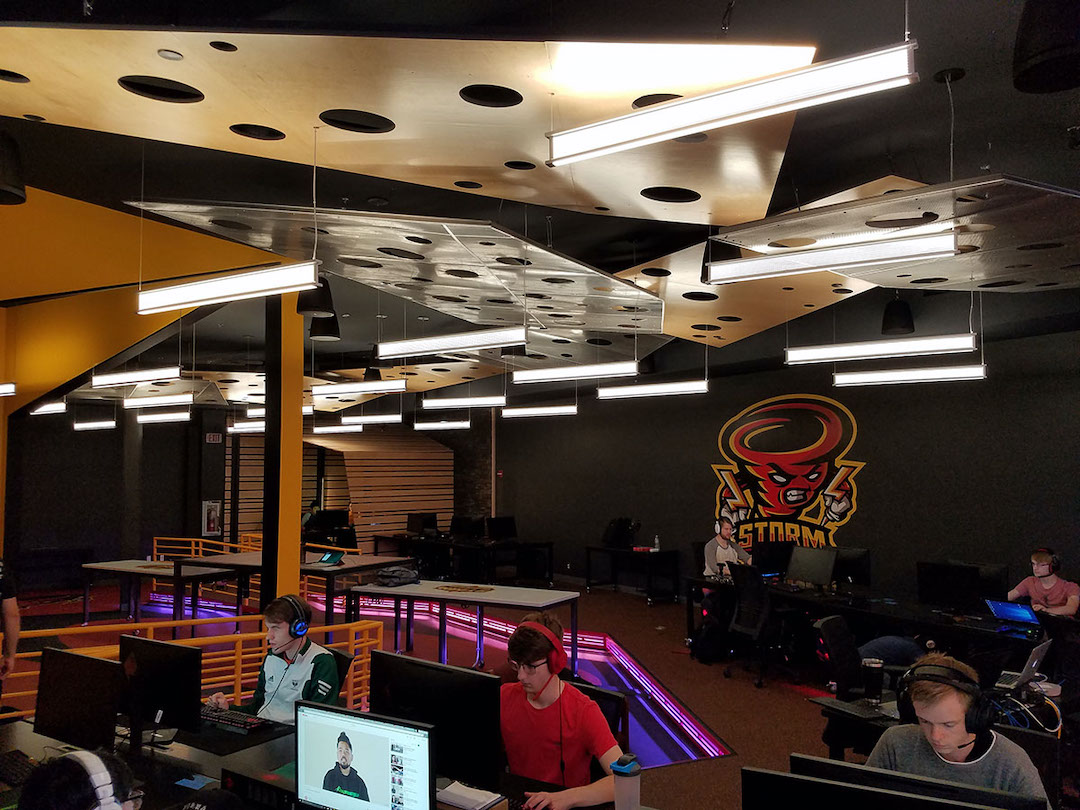 Photo courtesy HU.
Photo courtesy HU.
The entirety of the arena’s power and data cabling runs beneath a custom-designed raised floor with 35 grommets that open access panels. “This design element allows HU to rearrange the gaming stations, pull cable, and quickly rearrange the entire training arena,” said Dubbs. “The concealed cabling is also a safety solution; students can move freely about the space without any trip hazards.”
In fact, the only static power and data in the entire arena was installed in the center core island, or “bullpen,” which is hardwired to the sides of the tables. The bullpen supports team meetings, strategy sessions, socializing, dinners, and other collaborative activities, so having access to technology was vital.
 Photo courtesy HU.
Photo courtesy HU.
The eSports Training Facility differs from more commercial eSports arenas in that it is for players and coaches only. HU Storm matches are viewed in an auditorium in another part of the Whitaker Center for Science and the Arts, meaning everything in the space is designed to help the Storm master their skills; you won’t find branded food and beverage options, a stage for the eSports athletes to play on, or other spectator-focused amenities like premium seating options.
Another lesser-known college, however, has decided to use commercial eSports stadiums as a template to create the largest on-campus collegiate eSports arena in the country.
The Fortress eSports arena at Full Sail University
The Fortress, Full Sail University’s new $6 million eSports arena, is an 11,200-sf space that can accommodate 100 eSports athletes and over 500 live spectators simultaneously. Designed by Blackenship Architects, the arena, much like HU’s Training Facility, was built to be as flexible as possible in order to support any size eSports event. Unlike HU’s space, however, The Fortress was designed not only to be at the forefront of eSports facilities for the college’s athletes, but for spectators as well.
As such, The Fortress features 10 million pixels of LED wall, a concert level PA system, modular wood beam ceilings, live streaming equipment, dynamic sound and lighting solutions, the latest generation live video equipment by Ross Video, Sony video monitors and cameras, large high-resolution LED screens by Absen, multi-zone loudspeaker systems by L-Acoustics, media servers by Green Hippo, and high-bandwidth dedicated internet connectivity. All of this technology combines to create an “intense spectator experience,” according to Stella Posada, Sr. VP of Image & Design at Full Sail University. “We knew we wanted to provide the best eSports experience for both competitor and viewer alike, so it was a priority that we collaborated with thought leaders throughout our various internal teams,” Posada said.
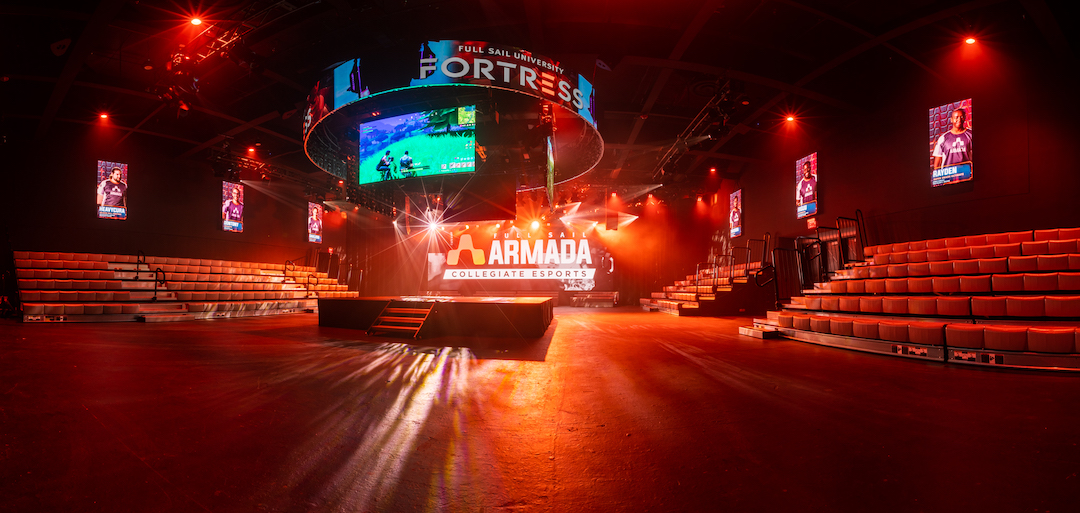 Photo courtesy Full Sail University.
Photo courtesy Full Sail University.
And while Full Sail University approached the project using commercial eSports venues as inspiration, The Fortress also fulfills a unique roll for the school’s students. Each live event hosted in the space provides students the opportunity to hone their skills in areas beyond eSports, such as show production, film, graphic design, gaming, and entertainment and business.
Overall, the school approached the design of The Fortress with three main goals:
– Create a leading-edge facility to support its collegiate level eSports team, Armada
– Create a space to serve as an experiential educational learning environment
– Create a space that supports collegiate and professional level eSports events, while adding to the technology and eSports landscape of the region
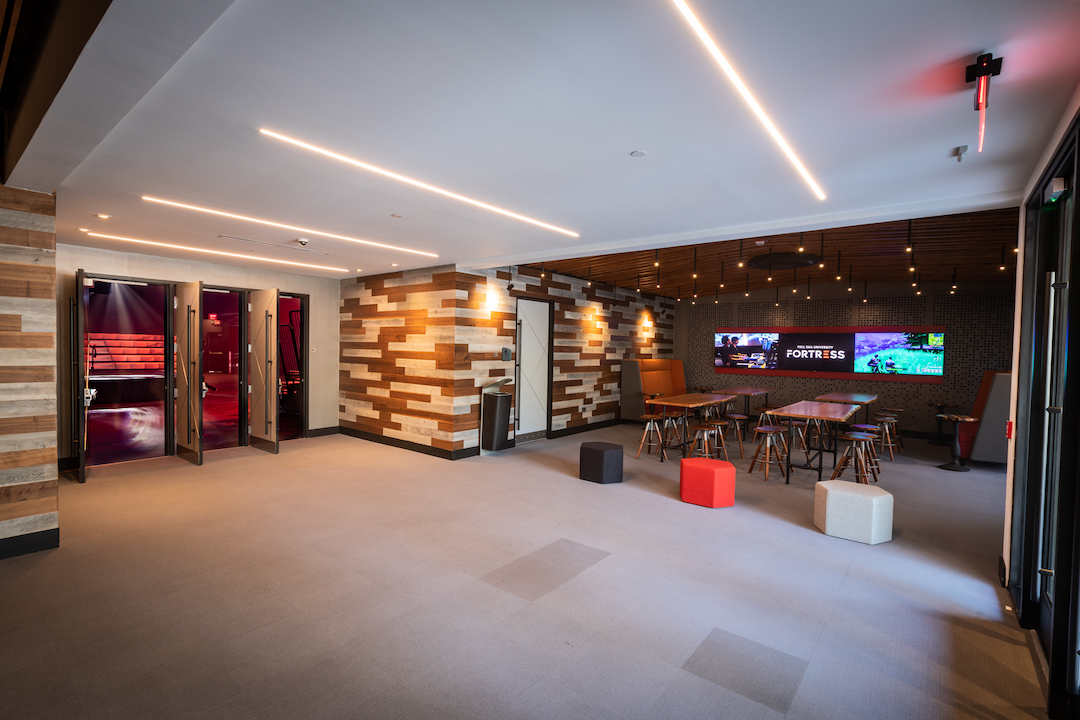 The Fortress lobby space welcomes spectators into the arena before ushering them into the main gaming and viewing space. Photo courtesy Full Sail University.
The Fortress lobby space welcomes spectators into the arena before ushering them into the main gaming and viewing space. Photo courtesy Full Sail University.
Additionally, the campus’s aesthetic had to be taken into account. “The Fortress at Full Sail University was created as a continuation of the fluid campus design allowing seamless spaces to merge throughout the campus,” Posada said.
To date, The Fortress has hosted varied events such as Call of Duty tournaments; Red Bull’s regional fighting game series, Conquest; and the Hearthstone collegiate championship finals.
Division 1 eSports arenas: Is Goliath preparing a counterattack?
While smaller universities are currently the vanguard for collegiate eSports venues, it may just be a matter of time before larger schools join the party.
Although they haven’t quite committed to the same level as smaller schools, D-I schools such as Ohio State University, Penn State, and Georgia Tech all have eSports teams that are actively competing in tournaments. Ohio State has even opened its own version of an eSports Arena with 80 gaming computers, consoles, and virtual reality systems; a room for competitive gaming with peer universities; and a broadcast booth.
Although the space is less “arena” and more “computer lab,” it is still a sign that D-I schools are taking eSports seriously. And while there isn’t the eSports equivalent of Duke’s Cameron Indoor Stadium or USC’s Coliseum yet, “yet” may be the key word in this equation.
See Also: With a new type of stadium comes a new type of premium seat
“Larger universities that have heavy technology majors are getting involved, but the majority have clubs within their student life or activities departments and are not yet embracing the incorporation of eSports into their athletic programs,” Dubbs said. “However, with the revenue for eSports approaching $1.5 billion, I believe larger universities will eventually become involved because the potential for increasing their revenue stream will be too tempting to ignore.”
For now, the David’s of the college landscape (HU, Full Sail University) are leading the eSports charge, but it won’t be long until a Goliath comes along and builds a university eSports arena to rival even the leading commercial facilities in the world. With revenue in the billions, it’s less a matter of “if,” and more a matter of “when.”
Related Stories
Sports and Recreational Facilities | Dec 7, 2015
High tech material makes Minnesota Vikings' new stadium's roof light and strong
U.S. Bank Stadium will have an ETFE (ethylene tetrafluoroethylene) pneumatic roof, a durable, flexible material made of a polymer similar to Teflon.
Sports and Recreational Facilities | Dec 3, 2015
Herzog & de Meuron unveils renderings of redeveloped stadium for Chelsea FC
As many as 264 brick piers will line the perimeter of the stadium and extend to a steel ring perched above the field.
Sports and Recreational Facilities | Nov 16, 2015
Edmonton's Rogers Place among North America's 'next-gen' stadiums
The home of the NHL’s Edmonton Oilers made Curbed’s list of 11 next-generation stadiums in North America. Also on the list are new venues for the NFL’s Atlanta Falcons and the NBA’s Milwaukee Bucks.
Sports and Recreational Facilities | Nov 13, 2015
It’s time to make MLB stadiums safer
Major League Baseball doesn't have official stadium design guidelines. Skanska's Tom Tingle has three ways the league can make the game safer for fans while still preserving its integrity.
Office Buildings | Nov 6, 2015
Real Madrid to get new headquarters designed by Rafael de La-Hoz
The design of the building is made of a set of two parallelepiped-shaped volumes.
Sports and Recreational Facilities | Nov 2, 2015
MJA Studio proposes converting Australian stadium into giant surf pool
The Subiaco Oval, which was built in 1908, could become the Subi Surf Park, a complex with apartments, stores, and a 300-meter-long wave pool.
Sports and Recreational Facilities | Sep 25, 2015
Italian soccer stadium designed to look like translucent waves
Architect Massimo Guidotti created a sinuous design for the stadium, which can support up to 16,000 seats.
Sports and Recreational Facilities | Sep 21, 2015
Tokyo Olympic Stadium saga ends for Zaha Hadid
After resubmitting a bid, the firm will not design the main venue for the 2020 Olympics after all.
Sports and Recreational Facilities | Sep 2, 2015
Proposed stadium for NFL's St. Louis Rams offers more than just football
The stadium's newest features have been unveiled by HOK, which could give the Rams one of the most inventive homes in the league—if it gets built.
Sports and Recreational Facilities | Aug 24, 2015
Green Bay Packers to start construction on a business district near Lambeau Field this fall
Flush with cash, the NFL team is kicking in about half of the $130 million for the 20-acre project’s first phase.


